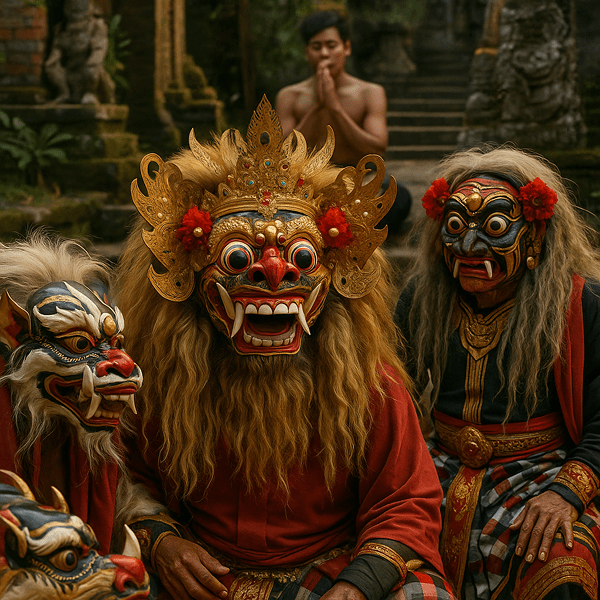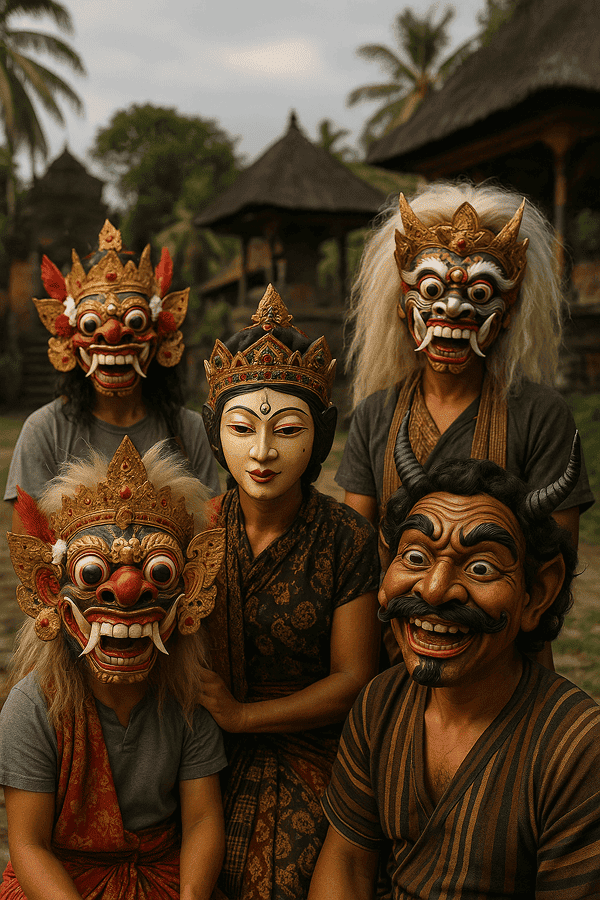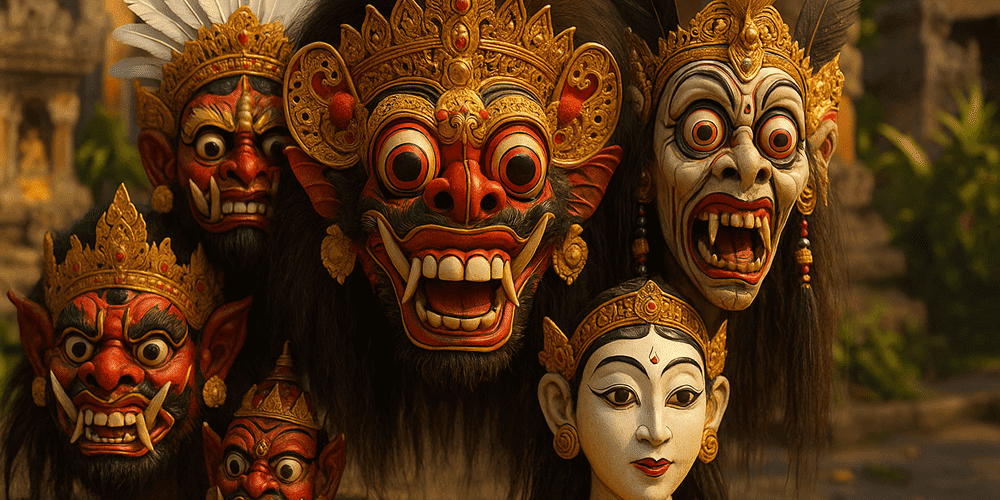Bukit Masks are a distinctive and culturally rich form of ritual and performance art from Indonesia, primarily associated with the island of Bali and certain regions of Java. These masks are celebrated for their bold, expressive features, often displaying exaggerated eyes, wide mouths, and intricate carvings. Many Bukit Masks are adorned with vivid colors — red, white, gold, and black — along with decorative elements such as feathers, beads, or gold leaf. Their dramatic appearance is not only a visual hallmark but also serves to embody spiritual forces and mythological beings. Bukit Masks are integral to a variety of religious ceremonies, traditional dances, and community festivals, reflecting the deep intertwining of art and spirituality in Indonesian culture. Their origins are ancient, with traditions believed to have emerged as early as the pre-Hindu period, and they remain a vital part of local identity and performance today.
Historical Origins of Bukit Masks
The origins of Bukit Masks are deeply rooted in the spiritual and artistic evolution of the Indonesian archipelago. The name “Bukit” comes from the Indonesian and Balinese word for “hill” or “highland,” referencing both the geographical origins and the elevated status of these masks in traditional society. Early forms of Bukit Masks likely developed from animistic rituals and ancestor worship, where masks were used to represent spirits, gods, or revered ancestors during communal ceremonies. With the arrival of Hinduism and later Buddhism in Indonesia, the design and function of Bukit Masks evolved, incorporating new religious stories and iconography. Over centuries, these masks became central to temple festivals, theatrical performances, and rites of passage. Inscriptions, temple reliefs, and ancient texts document their use in royal courts and village rituals. As with Topeng Masks — another important Indonesian mask tradition — Bukit Masks have undergone stylistic shifts over time, adapting to local histories, materials, and performance needs.
Cultural Significance and Symbolism of Bukit Masks
Bukit Masks hold profound symbolic meaning in their native culture. They are considered vessels for spiritual energy, capable of channeling the presence of gods, demons, or protective ancestors. During rituals and performances, the wearer of a Bukit Mask is believed to be temporarily possessed or guided by the spirit the mask represents, enabling direct communication between the human and supernatural realms. Common characters include Barong (a lion-like protective spirit), Rangda (a fearsome witch), and various animal or ancestral figures. Each mask’s features and colors are carefully chosen to express specific qualities — red for power, white for purity, gold for divinity, and black for mystery or protection. Legends and myths abound, such as stories of Barong and Rangda battling for cosmic balance. Socially, Bukit Masks reinforce group identity, teach community values, and serve as a means of collective catharsis during festivals and ceremonies.

Materials and Craft Techniques of Bukit Masks
The creation of Bukit Masks is a revered craft, often passed down through generations of master carvers (undagi or tukang topeng). Traditional materials include lightweight woods such as pule, crocodile wood, or jackfruit, prized for their fine grain and carving properties. The process begins with the ritual selection and blessing of the wood, followed by rough shaping, detailed carving, and smoothing. Artisans use chisels, knives, and special engraving tools to achieve dramatic facial expressions and ornate details. The surface is painted with natural or commercial pigments and sometimes gilded with gold leaf. Decorative elements such as feathers, beads, and horsehair may be added to enhance the mask’s presence and symbolism. Regional differences are evident: Balinese Bukit Masks tend to be more ornate, with elaborate crowns and intricate painting, while Javanese variants may be more restrained and stylized. Color symbolism is crucial — each hue and pattern carries spiritual significance and is chosen to suit the intended use of the mask.
Functions and Uses of Bukit Masks
Bukit Masks serve a range of ritual, theatrical, and communal purposes. In religious contexts, they are worn in temple ceremonies, processions, and exorcisms to invoke spiritual protection, bless the community, or ward off evil. In performance, Bukit Masks are central to traditional Balinese dance dramas, such as Barong and Rangda, where they help to tell stories of good versus evil, cosmic balance, and ancestral wisdom. Masks are also featured in village festivals, rites of passage, and harvest celebrations, providing entertainment, education, and spiritual renewal. Over time, the use of Bukit Masks has adapted to modern contexts, including cultural tourism, museum exhibitions, and contemporary art installations. Today, they remain a vibrant symbol of Balinese and Indonesian identity, bridging the worlds of ritual, performance, and everyday life.
Regional Variations of Bukit Masks
While Bukit Masks are most commonly associated with Bali, regional variations exist across the Indonesian archipelago. In Bali, masks from the highland Bukit region are noted for their bold features, vibrant colors, and dramatic expressions, often used in Barong and Rangda performances. In Java, Bukit-style masks may appear in traditional wayang topeng dance dramas, with more subdued colors and stylized forms. Other islands, such as Lombok and Madura, have developed their own mask traditions, each reflecting local myths, materials, and aesthetics. Regional workshops may also experiment with scale, ornamentation, or hybrid characters, blending indigenous and imported motifs. Compared to Topeng Masks, Bukit Masks tend to be more spiritually charged and tied to specific ritual functions, though both share a common heritage of Indonesian performance art.

Famous Examples and Collections of Bukit Masks
Notable examples of Bukit Masks can be found in museum collections and temple treasuries throughout Indonesia. The Bali Museum (Denpasar), Museum Puri Lukisan (Ubud), and Museum Negeri Propinsi Bali hold outstanding collections, including masks used in royal and village ceremonies. Significant private collections are maintained by master carvers and performance troupes, some of which are displayed during temple festivals or cultural events. Archaeological finds, such as ancient wooden masks and temple carvings, provide evidence of the tradition’s antiquity. Internationally, Bukit Masks are featured in exhibitions at institutions like the Museum of International Folk Art (Santa Fe) and the British Museum. Online resources, such as toddmasks.com, offer virtual galleries and expert analysis, making these cultural treasures accessible to a global audience.
Influence of Bukit Masks on Art and Culture
Bukit Masks have had a lasting impact on Balinese and Indonesian art, theater, and design. Their expressive forms and mythological themes inspire painters, sculptors, dancers, and filmmakers. In literature and film, the image of the Bukit Mask often symbolizes transformation, the battle between good and evil, and the interplay between the sacred and the mundane. Mask motifs appear in fashion, jewelry, festival decorations, and stage design, reflecting the enduring power of traditional aesthetics. The continued presence of Bukit Masks in public celebrations, art projects, and educational initiatives reinforces their vital role in preserving and transmitting Indonesia’s cultural heritage.
Contemporary Status and Preservation of Bukit Mask Traditions
Today, the tradition of Bukit Mask making and performance is actively maintained by master artisans, dance troupes, and cultural organizations. Artisans continue to teach the craft through apprenticeships, workshops, and family lines, ensuring the survival of carving, painting, and performance skills. Museums, cultural centers, and government initiatives support preservation through exhibitions, festivals, and documentation projects. Innovations are also embraced: artists experiment with new materials, contemporary themes, and digital media to keep the tradition relevant. Educational programs and masterclasses — often highlighted on toddmasks.com — introduce new generations to the history and artistry of Bukit Masks, fostering pride and creative engagement within and beyond Indonesia.
Collecting and Acquiring Bukit Masks
The market for Bukit Masks includes authentic ceremonial pieces, high-quality replicas, and contemporary interpretations. Masks can be acquired from artisan workshops, museum shops, galleries, and reputable online sources. Price ranges vary according to age, craftsmanship, materials, and provenance; antique or artist-signed masks are especially prized by collectors. When collecting, it is essential to seek expert advice, verify authenticity, and prioritize ethical sourcing that supports local artists and communities. Toddmasks.com offers guidance on authentication, valuation, and the cultural context of Bukit Masks, ensuring responsible collecting and respect for sacred traditions.
